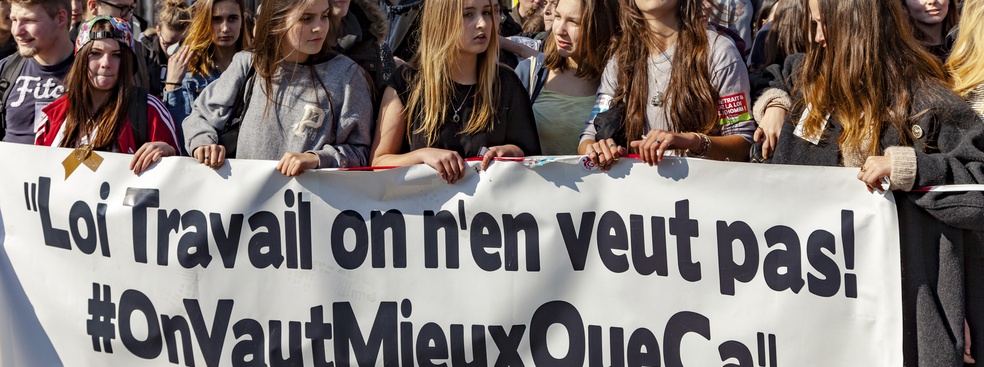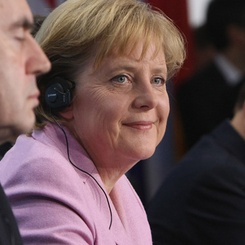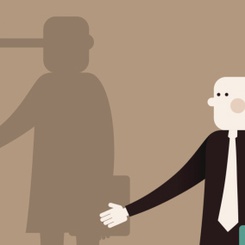In general, trade unions in the Western world experienced their period of glory in the late 19th century, when manufacturing, dominated by large firms, was the principal driver of wealth creation. Such firms wielded tremendous market power. On the one hand, by exploiting their oligopoly status in consumer markets, they were able to maintain high prices. On the other hand, they used their monopsony* position in the labour market, stemming from the low worker mobility, to keep wages low. Unions as workers’ coalitions appeared naturally to rebalance the labour market and recapture some of the “rents” through tough bilateral negotiations.
Over the last 50 years, however, the structure of Western economies has changed dramatically, propelled by globalization and technological progress. Fewer barriers to trade and lower transportation and communication costs have lessened national protectionism to create global markets for a broad range of goods and services. Formerly large and protected national firms are now multinationals which must compete with other similar firms in global markets. This competition has caused them to produce and assemble products in low-wage countries while retaining design, R&D, communication and marketing in the home country. The large factory, hiring thousands of workers performing repetitive tasks, is an image of the past. With the elimination of manufacturing jobs, service jobs constitute more than two-thirds of the wealth produced annually in the rich nations. Furthermore, the largest share of this output is produced by small and medium size firms in all sectors, including the most dynamic Hi-Tech fields.
In this new economic environment, the social utility of trade unions is questionable. With notable exceptions (fast food, for instance), companies no longer possess monopsony power in the labour market, as worker mobility has dramatically increased geographically and across professions requiring identical skills. Companies’ ability to generate abnormally high profits by maintaining high prices in the consumer markets has also weakened by increased global competition and a flattened demand curve for all companies. Thus, when unions aggressively vie for higher wages, they merely help to economically weaken the host firm towards its eventual demise. The “monopsony” argument might still be applicable to jobs in the public sector, where the only employer is the government, yet employees can and do now move to the private sector. This freedom of movement can prevent wage constraints significantly more efficiently than can the civil servants’ unions. People realized that unions can provide them fewer services today than they previously could, and unsurprisingly, membership is steadily decreasing in the developed countries.
With respect to French unionism, during the second World War, French trade unions actively resisted the occupation. So, in the aftermath of the war, it appeared normal to reward them. They were granted the legal right to negotiate collective labour agreements at the firm and branch levels and were allowed to co-manage, with employers’ representatives, the social security system of France. The five largest national union confederations, which obtained legal representativeness, were the CGT, the CFDT, the FO, the CFE-CGC and the CFTC. Even if the criteria for legal representativeness changed in 2008, by requiring a minimum number of voters for the work councils in the firms, the same five large confederations satisfied the criteria.
In France the union membership rate was approximately 24% in the mid-1970s. Today, union membership represents only 8% of total employment, the lowest proportion in the European Union. This percentage conceals significant discrepancies between public sector jobs with a 15% membership rate (15.2% among employees employed directly by the state and 14.7% in state-owned companies and social security provisions) and private sector jobs (5%) [Fulton, 2015]. Because of the legal definition of a representative union, unions with such a low membership rate negotiate labour agreements in branches and companies that represent 90% of the French workforce.
Given the tremendous economic changes underway, unions are correct to fear that some of their protected missions may be eliminated. Certain questions necessarily arise. For instance, the global performance of the retirement system is poor, with deficit accumulating year after year. Why should worker and employer unions co-manage the retirement and pension system, while no retired person is a union member? Why should unions with such low membership co-manage career centres and the unemployment insurance system, despite the fact that in France, unemployed persons are normally not union members? Entire common interest services could be more effectively managed by the State when they cannot be transferred to the private sector.
The labour market in France is noticeably dysfunctional, with a two-digit unemployment rate and large long-term, youth and unskilled unemployment rates. No doubt action must be taken to help firms recover their competitiveness and help the least advantaged employees to obtain jobs.
The fact that unions with a membership rate of 8% continue negotiating wages on behalf of 90% of employees is possibly contributing to the high unemployment rate in France. Self-regarding wage negotiations at the firm level explain why contrary to many other EU countries, Germany included, unit labour costs continued increasing during the worst economic recession since the second oil price shock (2007-2009) and after. In what might be a severe economic mistake, in 2013, the French government legalized massive corporate tax deductions proportional to total wages. Because of unions’ considerable negotiating power, companies increased wages without hiring, with little impact on total employment.
In the last few months, from March to June, a conflict developed between unions and the socialist government of Manuel Valls. In March, Labour Minister Myriam El Khomri unveiled a set of reforms for the labour market that aim to increase its flexibility, following the example of many neighbouring countries. The governments’ intended reforms targeted the most disadvantaged persons, namely temporary workers and the unemployed. These persons are not union members and likely do not protest in the streets. All unions protested the reforms. The unions were backed by opinion polls on a majority of individuals, in general those with prized jobs protected by “open-ended” labour contracts or a civil servant status, and students, who are the least exposed to the risk of unemployment.
After several strikes and street protests, the government revised the reform and got the support of the first union confederation (by size, not representativity), the CFDT [Fulton (2015), mentions 868,600 members]. The only fundamental measure surviving from the initial text was Article 2, which permits distressed companies to negotiate at the firm level with employees on wage and working time adjustments that are less favourable than the terms resulting from branch negotiations.
In May, however, the other unions demanded major strikes and organized several marches, comprising tens of thousands of people in the streets who shouted their opposition to the proposed labor law reform and the government. The CGT and FO, supported by smaller but tough unions, illegally blocked roads and harbours, ceased work in oil refineries, reduced the production of some nuclear power plants, and blocked waste collection in some large cities. The strongest discontent with the reform was voiced by the ideologically left-oriented union, the Confédération générale du travail (CGT, www.cgt.fr). The CGT is likely one of the two largest confederations of France, with an estimated membership of 682,000 members [Fulton, 2015]. To maintain their appeal and preserve membership and influence, unions must systematically “show their muscle”, that is, signal to the government that they will block attempts to pass serious reforms. In this strategic interaction over time, unions know that if they send credible signals, then the government might refrain from proposing more ambitious reforms in the future.
Observing this Kafka-like conflict, it seems that unions changed from being protectors of workers’ rights at the firm level to being lobbies for the legal status quo. Hence, from a short-term perspective, unions’ protest is favourable to “insiders”, that is those who have the best jobs on open-ended contracts, yet detrimental to the unemployed and temporary workers. From a long-term perspective, the existing industrial organization of the French labour market is dampening the competitiveness of the French firms and the growth prospects of France.
In this latter perspective, the government should maintain this reform, and other reforms should be proposed. The next government must prepare for arduous negotiations with the declining unions. Wounded adversaries are the most dangerous opponents because they have little to lose.









